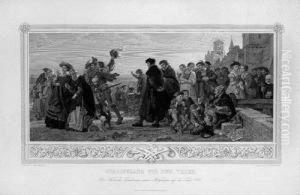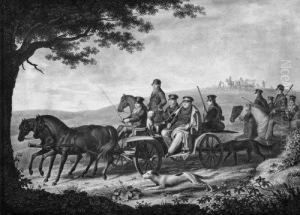Carl August Schwerdgeburth Paintings
Carl August Schwerdgeburth was a 19th-century German painter and engraver who was known for his historical scenes and portraits. Born on March 15, 1802, in Weimar, Germany, Schwerdgeburth became associated with the Weimar School of painting, which was part of a larger cultural movement in the region known as Weimar Classicism. This movement, which encompassed literature, philosophy, music, and the visual arts, was marked by its emphasis on classical ideals and forms.
Schwerdgeburth received his early training from the local painter and engraver Friedrich Müller, and later attended the Weimar Princely Free Drawing School, where he was a student of the court painter Georg Melchior Kraus. His education continued as he studied with the famous German painter Johann Friedrich Overbeck, who was a leading figure of the Nazarene movement—a group of Romantic painters who sought to revive the spirit and techniques of medieval and early Renaissance art.
Throughout his career, Schwerdgeburth remained active in Weimar, where he received commissions from the court and became a respected member of the artistic community. He was appointed as court painter, which was a significant honor and recognition of his talents. His works often depicted historical subjects and figures from German history, and he was particularly noted for his portraits of notable individuals of his time, including Goethe and Schiller, two of the most prominent figures of Weimar Classicism.
Schwerdgeburth's style was characterized by its fine detail, clear composition, and adherence to classical principles of art. Despite the changing tides of artistic fashion during his lifetime, including the rise of realism and impressionism, he remained committed to the traditional values and techniques that he had learned during his formative years.
He passed away on December 30, 1878, in Weimar. Although Schwerdgeburth may not be as widely recognized today as some of his contemporaries, his work provides a valuable insight into the artistic culture of 19th-century Germany and the legacy of Weimar Classicism. His contributions to German art were significant during his lifetime, and his historical paintings and portraits continue to be studied for their craftsmanship and historical value.

